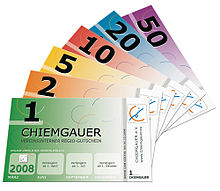Chiemgauer
The Chiemgauer belongs to the Regiogelder family and was started in January 2003 by a student project of the 10th grade of the Chiemgau Waldorf School in Prien based on a concept by the accompanying business teacher Christian Gelleri. In June of the same year the sponsoring association of the Chiemgauer with the same name was founded at the school. Due to the dynamic growth of the initiative, the project broke away from the Waldorf School in summer 2005.
The economic processing has been the responsibility of the social cooperative Regios eG since 2008, the ideal sponsor is the Chiemgauer e. V. with 3,600 members, including 600 companies and 250 non-profit associations from the region. The aim of the Chiemgau regional money is to strengthen and develop regional economic cycles and to promote non-profit associations in the Chiemgau region . The distribution area is limited to the districts of Rosenheim and Traunstein with 480,000 inhabitants.
The Chiemgau regional money is available as a voucher system and in cashless form, the Regiocard. The Chiemgauer-Initiative cooperates in account management and payment processing with regional and ethically and ecologically oriented banks.
In order to be able to participate in the Chiemgauer, all users of the regional money, i.e. consumers, companies, associations, municipalities and other partners, become members of the sponsoring association. Membership serves as a legal demarcation from the legal tender and the application of the association's internal rules. The idea behind it is a direct democratic self-administration of the initiative.
Exchange rate
Chiemgauers can be bought by consumers with a value of 1: 1 for euros , but can only be exchanged for a fee of 5% ("regional contribution") in euros. Of the 5%, 60% go to a non-profit organization. Which club is funded is determined by the person who exchanges euros for regional money. The remaining 40% are used to cover the publisher's costs.
validity
Exchanged vouchers are valid for six months. After expiry, the validity of the Chiemgauer-Scheine can be extended by buying and sticking a sticker worth 3% of its value (→ circulation secured money ). The Chiemgauer series are exchanged after three years. Chiemgauer notes that are more than four years old will no longer be accepted for return. All users of Chiemgauer must also be a member of the Chiemgauer e. V. be.
The electronic Chiemgauer has a circulation impulse of 0.016% per day, which means 5.84% over the course of a year. However, it is only counted after the Chiemgauer remained in the account for three months. The circulation impulse, originally 1% per month and without grace periods, has been continuously reduced since it existed. The circulating Chiemgauer money supply has stagnated at around 900,000 Chiemgauer since then.
Security features
The notes with a value of 1, 2, 5, 10, 20 and 50 euros have 14 security features. The notes are individually numbered and provided with a barcode for verification. They have a real watermark, are provided with guilloche and copy protection technology and show UV features for checking with money validators.
cover
Chiemgauer are covered by Euro 1 to 1. The issuing association has set up a reserve at a bank for the voucher variant. The cashless variant is covered by the cooperating banks.
Current numbers
At the end of 2015, the regional money was accepted by 593 companies and used by almost 3,900 members. There were over 694,000 Chiemgau residents in circulation. The sales of the Chiemgauer network were 70,000 euros in the first year 2003, 3 million euros in 2008 and 7.4 million euros in 2014. The annual growth from 2008 to 2009 was 21%. This makes the Chiemgauer currently the largest regional money system in German-speaking countries and one of the most successful complementary currencies in the world.
literature
- Mathias Weis, Heiko Spitzeck: The money complex. Head. Bern-Stuttgart-Vienna 2008. ISBN 978-3-258-07314-9 . With contributions to regional money by Christian Gelleri, Hugo Godschalk, Bernard Lietaer, Gerhard Rösl.
- Margrit Kennedy , Bernard A. Lietaer : Regional currencies. Riemann, Munich 2004. ISBN 3-570-50052-7
- Associative economic spaces by Christian Gelleri, Questions of Freedom 2005 (PDF file; 255 kB)
- Regional development with regional money by Christian Gelleri, Technical University of Munich, 2006 (PDF file; 104 kB)
Media (film)
- Chiemgauer in the series "Planet Wissen" of the ARD from September 25, 2014
- Chiemgauer on Bavarian TV ( memento from July 31, 2009 in the Internet Archive ) from July 27, 2009
- Chiemgauer on ORF 1, January 2009
- Chiemgauer on Deutsche Welle (August 2009)
Media (newspapers and magazines)
- Money is what counts, June 2009 (PDF file; 390 kB)
- Anti-Globalizers ' Money , Die Zeit , August 5, 2004
- stern.de August 29, 2004
- That works: That makes two Chiemgauer, please!
Web links
Individual evidence
- ↑ The Chiemgauer in practice (PDF)
- ↑ http://www.chiemgauer.info/
- ↑ Chiemgauer statistics 2003 to 2014 (PDF; 83 kB)
